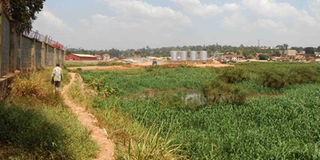Prime
570,000 hectares of wetlands lost

A section of the degraded Kinawataka wetland. PHOTO BY STEPHEN OTAGE
What you need to know:
Bundibugyo tops the districts with highest wetland loss, followed by Nakapiripirit, Mubende and Amuria respectively.
KAMPALA
Uganda has in the last 15 years lost 569,021 hectares of wetlands in various parts of the country. As the world celebrates Wetland Day today, a December 2009 Biomass Study, which also computes the national biomass and forest cover indicates that wetland loss by far exceeds wetland gains in various districts.
Bundibugyo in western Uganda tops the districts with highest wetland loss, losing 72,000 hectares between 1990 and 2005. Nakapiripirit in the north east has lost over 42,000 hectares in the same period while Mubende in central region lost 23,000 hectares and Amuria in the north lost 19,000 hectares. Some districts like Bududa in the east now have no wetlands, down from 392 hectares in 1990.
Some districts like Kiruhura, Masaka, Nakasongola and Bushenyi, however, have made gains in wetland size. The Commissioner of Wetlands in the Ministry of Water and Environment, Mr Paul Mafabi, said the reasons for the wetland gains were the recent El Niño and conservation by residents which has given way for degraded wetlands to rejuvenate.
Wetland degradation is, however, still rampant. At least 11 wetlands are currently under siege by individuals and developers around the city and the Ministry of Water and Environment is pondering the next move on the encroachers.
The commandant of the newly-created Environmental Police, Mr Taire Idwege, said the Force and the Ministry of Water and Environment are investigating circumstances under which developers have acquired titled land in wetlands in Kampala, Entebbe and Mukono.
He says since the inception of the Force two months ago, several meetings have been held between the ministry and the National Environment Management Authority (Nema), tasking the agency to carry out an audit of all the wetlands in the country and their demarcations.
“We have 11 sites under question in Kampala, Entebbe and Mukono. We are looking for the owners and ascertain if they have environmental impact assessment from Nema,” he said without revealing the exact location of the affected wetlands.
The Minister for Water and Environment, Ms Maria Mutagamba, announced ahead of the celebrations today, that the government had embarked on boundary demarcation and gazetting wetlands countrywide to enhance their conservation.This has, however, been long overdue. According to Robert Bakiika, the deputy executive director of Environmental Management for Livelihood Improvement Bwaise Facility, an NGO, the wetland management system is not being implemented properly.
In 1986, a Ministry for Environment Protection was established. Later in 1988, Uganda acceded to the Ramsar Convention, an intergovernmental treaty that embodies the commitments of its member countries to maintain conserve their wetlands.
“Government imposed a ban on large scale drainage of wetlands and later in 1989 established the National Wetlands Conservation Programme which was charged with formulation of the National Wetlands Policy. After a number of reforms, the management of wetlands was vested in the hands of districts as per the Local Government Act , 1997,” Mr Bakiika explains.
And indeed this seems to be the cause of wetland degradation.
“It is not true that Nema is not doing enough but the challenge is related to the fact that those involved in degradation do so with impunity, sometimes at night. But also sometimes this is being facilitated by the local authorities. Land boards are continuing to issue titles in wetlands which has also complicated matters. Nema inspectors are continuously carrying out inspections and surveillance,” said the Nema Public Relations Officer, Mr Naomi Karekaho.




